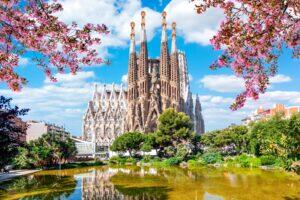Fodor's Expert Review Fossar de les Moreres
This low marble monument runs across the eastern side of the church of Santa Maria del Mar. It honors the defenders of Barcelona who gave their lives in the final siege that ended the War of the Spanish Succession on September 11, 1714, and who are buried in the cemetery that lies beneath the square.
The inscription (in English: "in the cemetery of the mulberry trees no traitor lies") refers to the graveyard keeper's story. He refused to bury those on the invading side, even when one turned out to be his son. This is the traditional gathering place for the most radical elements of Catalonia's nationalist (separatist) movement, on the Catalonian national day, which celebrates the heroic defeat.
From the monument, look back at Santa Maria del Mar. The lighter-color stone on the lateral facade was left by the 17th-century Pont del Palau (Palace Bridge), erected to connect the Royal Palace in the nearby Pla del Palau with the Tribuna Real (Royal Box) over the right side of... READ MORE
This low marble monument runs across the eastern side of the church of Santa Maria del Mar. It honors the defenders of Barcelona who gave their lives in the final siege that ended the War of the Spanish Succession on September 11, 1714, and who are buried in the cemetery that lies beneath the square.
The inscription (in English: "in the cemetery of the mulberry trees no traitor lies") refers to the graveyard keeper's story. He refused to bury those on the invading side, even when one turned out to be his son. This is the traditional gathering place for the most radical elements of Catalonia's nationalist (separatist) movement, on the Catalonian national day, which celebrates the heroic defeat.
From the monument, look back at Santa Maria del Mar. The lighter-color stone on the lateral facade was left by the 17th-century Pont del Palau (Palace Bridge), erected to connect the Royal Palace in the nearby Pla del Palau with the Tribuna Real (Royal Box) over the right side of the Santa Maria del Mar altar, so that nobles and occupying military officials could get to Mass without the risk of walking in the streets. The bridge, regarded as a symbol of imperialist oppression, was finally dismantled in 1987. The steel arch with its eternal flame that honors the fallen Catalans was erected in 2002.
READ LESS








